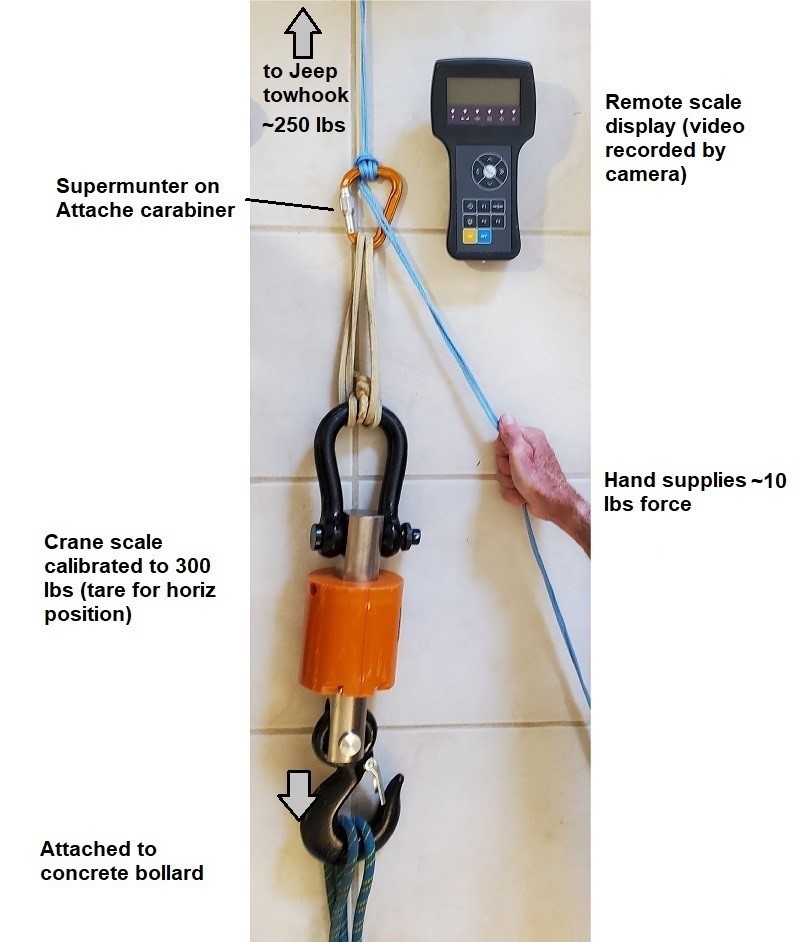
Will
a rap on thin Dyneema Amsteel kill you? Not if you use common sense. With 1/8" Amsteel, DON’T use
a rap device like an ATC or figure 8 derivative; use a superMunter or Munter with a twist (NOT just a
Munter; see this link)
on a carabiner,
and scale the Amsteel thickness as indicated at end. This is NOT an
“everyday
rap;” it is for emergencies, and super go-light situations. I've done
many Amsteel raps up to 155', but I weigh less that 150 lbs, and
usually go
slowly with just occasional overhangs. So let’s quantify with a more
extreme, controlled test.
The
rap simulation setup is shown below (the test was done in a parking
lot, not on
my tile floor!). Essentially the crane scale is seeing the force of a
person in a rap harness. Two tests pulled 80’ of double-strand 1/8”
Amsteel through a
supermunter at ~250-300 lbs, then let the Amsteel in the supermunter
sit on the
stationary, friction-heated carabiner for several minutes.

The equipment was laid out horizontally, and the force was measured by a calibrated crane scale attached to a large concrete bollard at the base of a light pole. Two strands of 1/8” (2500 lb test) Amsteel “Blue” braided Dyneema were hitched on an Attache carabiner with a superMunter. The “anchor end” was attached to the towhook of my jeep, which my wife drove forward so the 80’ “rap” was accomplished in 30 s. I gripped the brake end of the rope, and by adjusting the grip of my hand (just a few pounds of tension), kept the reading on the scale to 250-300 lbs.
In the first test, the scale force was 250 lbs (measured 249.9 +/- 40
lbs; note the force on the superMunter is a small amount greater, because it
is vector-summed with the force from my hand). After 80’ (double strand) had pulled through,
the ropes tangled, and the force went up to an average of 744 lbs for 3s,
giving the superMunter a pulse of high energy input, before we stopped the
experiment and lowered the tension. Significantly,
the supermunter was kept loaded with >400 lbs for ~100s after the “rap;”
during this time, the carabiner (now heated by more than the friction
equivalent to an 80’ free-hanging rap by a 250-lb person) was tight against the
same section of unmoving Amsteel. Contrary to popular belief, the biner
did not just slice through the Amsteel.
I couldn’t get to measure the temperature between hitch and carabiner for 38 s, when it was 77F above the ambient, or 150 F. I know from tests of carabiner/Munter cooling, it may have been as hot as 170F maximum ( based on other tests); again, this temperature may be biased more by the carabiner temperature). When I completely released the tension and inspected the Amsteel that had been inside the superMunter, I found the fiber was visibly undamaged. In fact I used the same rope for a rap the next day.
I repeated
this test, again pulling 80’ of double strand 2500 lb (1/8”) Amsteel through a
superMunter at 3.2 ft/sec average, using my hand to control the force to an average
of 290 +/- 49 lbs. Same results.
But
you have had rap devices burn your hand, and melt the outside of a rope! Well,
chances are that rope had a sheath made of Nylon, polyester, or aramid, which
has a much greater surface coefficient of friction (see graph below), so of
course it generated a lot of heat.

Well…
well… if Dyneema is so slippery, what slows you in a rap? Answer: bending and
deformation “friction.” Even with traditional rap devices on traditional ropes,
about half the “friction” is obtained from deformation and bending of the rope.
I
recommend you use this rule to select the Amsteel cord:
Lbs
break strength= 16*(your weight in lbs, with gear)
So
if you and your gear weigh 250 lbs, you would use 4000 lb bs Amsteel Blue,
which is about 5/32” diameter, and if you weigh 150 lbs with gear, you would
use 2400 lb Amsteel, close to 1/8”. You don’t need all that breaking strength;
but the rated breaking strength is roughly proportional to the mass of material
in the cord per unit of length, and the greater the mass, the more dissipated
will be the heat generated in the cord.
Finally, use your common sense: the test above was done at an ambient of 73F, and was "just" 80'. Think twice if the ambient is 100F, or the length is more than 80'. But if you read the linked section you will see that low thermal conductivity allows Dyneema to contact “non-infinite” devices that start well above the melting point.